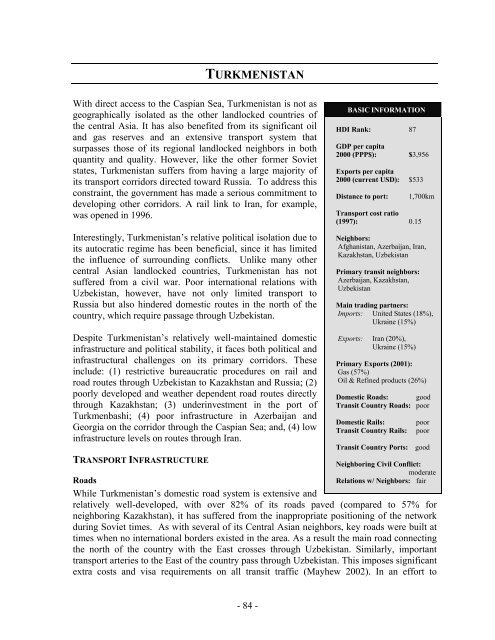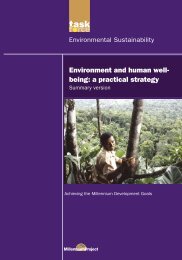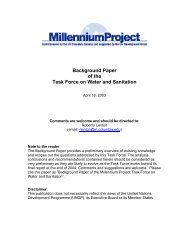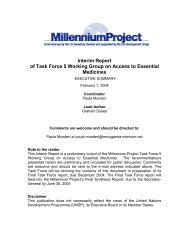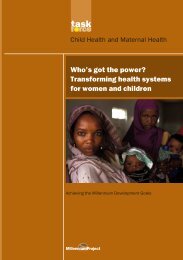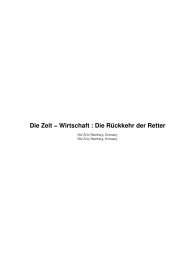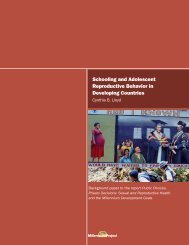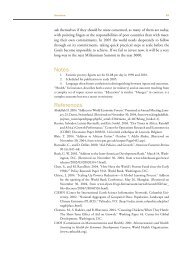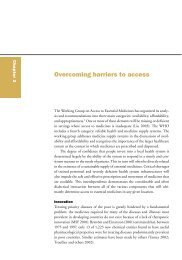the challenges facing landlocked developing countries: a case study ...
the challenges facing landlocked developing countries: a case study ...
the challenges facing landlocked developing countries: a case study ...
Create successful ePaper yourself
Turn your PDF publications into a flip-book with our unique Google optimized e-Paper software.
TURKMENISTAN<br />
With direct access to <strong>the</strong> Caspian Sea, Turkmenistan is not as<br />
geographically isolated as <strong>the</strong> o<strong>the</strong>r <strong>landlocked</strong> <strong>countries</strong> of<br />
<strong>the</strong> central Asia. It has also benefited from its significant oil<br />
and gas reserves and an extensive transport system that<br />
surpasses those of its regional <strong>landlocked</strong> neighbors in both<br />
quantity and quality. However, like <strong>the</strong> o<strong>the</strong>r former Soviet<br />
states, Turkmenistan suffers from having a large majority of<br />
its transport corridors directed toward Russia. To address this<br />
constraint, <strong>the</strong> government has made a serious commitment to<br />
<strong>developing</strong> o<strong>the</strong>r corridors. A rail link to Iran, for example,<br />
was opened in 1996.<br />
Interestingly, Turkmenistan’s relative political isolation due to<br />
its autocratic regime has been beneficial, since it has limited<br />
<strong>the</strong> influence of surrounding conflicts. Unlike many o<strong>the</strong>r<br />
central Asian <strong>landlocked</strong> <strong>countries</strong>, Turkmenistan has not<br />
suffered from a civil war. Poor international relations with<br />
Uzbekistan, however, have not only limited transport to<br />
Russia but also hindered domestic routes in <strong>the</strong> north of <strong>the</strong><br />
country, which require passage through Uzbekistan.<br />
Despite Turkmenistan’s relatively well-maintained domestic<br />
infrastructure and political stability, it faces both political and<br />
infrastructural <strong>challenges</strong> on its primary corridors. These<br />
include: (1) restrictive bureaucratic procedures on rail and<br />
road routes through Uzbekistan to Kazakhstan and Russia; (2)<br />
poorly developed and wea<strong>the</strong>r dependent road routes directly<br />
through Kazakhstan; (3) underinvestment in <strong>the</strong> port of<br />
Turkmenbashi; (4) poor infrastructure in Azerbaijan and<br />
Georgia on <strong>the</strong> corridor through <strong>the</strong> Caspian Sea; and, (4) low<br />
infrastructure levels on routes through Iran.<br />
TRANSPORT INFRASTRUCTURE<br />
Roads<br />
While Turkmenistan’s domestic road system is extensive and<br />
BASIC INFORMATION<br />
HDI Rank: 87<br />
GDP per capita<br />
2000 (PPP$): $3,956<br />
Exports per capita<br />
2000 (current USD): $533<br />
Distance to port:<br />
1,700km<br />
Transport cost ratio<br />
(1997): 0.15<br />
Neighbors:<br />
Afghanistan, Azerbaijan, Iran,<br />
Kazakhstan, Uzbekistan<br />
Primary transit neighbors:<br />
Azerbaijan, Kazakhstan,<br />
Uzbekistan<br />
Main trading partners:<br />
Imports: United States (18%),<br />
Ukraine (15%)<br />
Exports: Iran (20%),<br />
Ukraine (15%)<br />
Primary Exports (2001):<br />
Gas (57%)<br />
Oil & Refined products (26%)<br />
Domestic Roads: good<br />
Transit Country Roads: poor<br />
Domestic Rails:<br />
Transit Country Rails:<br />
relatively well-developed, with over 82% of its roads paved (compared to 57% for<br />
neighboring Kazakhstan), it has suffered from <strong>the</strong> inappropriate positioning of <strong>the</strong> network<br />
during Soviet times. As with several of its Central Asian neighbors, key roads were built at<br />
times when no international borders existed in <strong>the</strong> area. As a result <strong>the</strong> main road connecting<br />
<strong>the</strong> north of <strong>the</strong> country with <strong>the</strong> East crosses through Uzbekistan. Similarly, important<br />
transport arteries to <strong>the</strong> East of <strong>the</strong> country pass through Uzbekistan. This imposes significant<br />
extra costs and visa requirements on all transit traffic (Mayhew 2002). In an effort to<br />
poor<br />
poor<br />
Transit Country Ports: good<br />
Neighboring Civil Conflict:<br />
moderate<br />
Relations w/ Neighbors: fair<br />
- 84 -


